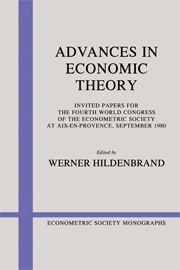Book contents
- Frontmatter
- Part I Economics of incentives
- Part II Information and the market mechanism
- Part III Non-Walrasian economics
- Part IV Repeated games
- Part V Topics in competitive analysis
- Chapter 7 The Cournotian foundations of Walrasian equilibrium theory: an exposition of recent theory
- Chapter 8 Recent results on the existence of Cournot equilibrium when efficient scale is small relative to demand
- Part VI Applied macroeconomics
- Part VI Industrial organization
Chapter 7 - The Cournotian foundations of Walrasian equilibrium theory: an exposition of recent theory
from Part V - Topics in competitive analysis
Published online by Cambridge University Press: 05 January 2013
- Frontmatter
- Part I Economics of incentives
- Part II Information and the market mechanism
- Part III Non-Walrasian economics
- Part IV Repeated games
- Part V Topics in competitive analysis
- Chapter 7 The Cournotian foundations of Walrasian equilibrium theory: an exposition of recent theory
- Chapter 8 Recent results on the existence of Cournot equilibrium when efficient scale is small relative to demand
- Part VI Applied macroeconomics
- Part VI Industrial organization
Summary
Introduction
It is well known that the modern versions of Walrasian economics (Debreu (1959); Arrow and Hahn (1971)) leave unexplained a key ingredient of the theory, namely the hypothesis that prices are quoted and taken as given by economic agents. In this exposition we shall attempt, via the extensive analysis of two models, to give an account of the efforts of the last decade to develop the classical work of Cournot (1838) into a full-fledged general equilibrium theory that provides an endogenous explanation of price taking (we will say much less about price quoting). Specific references will be given as we go along. For a gathering of relevant articles see the issue of the Journal of Economic Theory (1980) on noncooperative approaches to the theory of perfect competition.
The starting point of the research is the (informal) hypothesis that economic agents interact noncooperatively through given institutions. Those being essential, it cannot be expected that the same level of institutional parsimoniousness as in Walrasian theory can be reached. Because, as a consequence, all-encompassing models are bound to be cumbersome, the research has proceeded by focusing on particular, prototypical ones. This we shall do also. We will review two models. The first (Section 2), in the line initiated by Shubik (1973) and Shapley and Shubik (1977), is a model of exchange where all agents are treated symmetrically, that is, have, in principle, the same strategic position. The second (Section 3), in the line initiated by Gabszewicz and Vial (1972), Hart (1974a), and Novshek and Sonnenschein (1978), is a model of firms that face a sector of passively adjusting consumers but interact strategically among themselves.
- Type
- Chapter
- Information
- Advances in Economic Theory , pp. 183 - 224Publisher: Cambridge University PressPrint publication year: 1983
- 25
- Cited by



